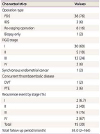1. Gupta D, Hull ML, Fraser I, Miller L, Bossuyt PM, Johnson N, et al. Endometrial biomarkers for the non-invasive diagnosis of endometriosis. Cochrane Database Syst Rev. 2016; (4):CD012165.

2. Santoro L, D'Onofrio F, Flore R, Gasbarrini A, Santoliquido A. Endometriosis and atherosclerosis: what we already know and what we have yet to discover. Am J Obstet Gynecol. 2015; 213:326–331.


4. Ferreira AL, Bessa MM, Drezett J, de Abreu LC. Quality of life of the woman carrier of endometriosis: systematized review. Reprod Clim. 2016; 31:48–54.

6. Lee AW, Templeman C, Stram DA, Beesley J, Tyrer J, Berchuck A, et al. Evidence of a genetic link between endometriosis and ovarian cancer. Fertil Steril. 2016; 105:35–43.e1.

7. Schleedoorn MJ, Nelen WL, Dunselman GA, Vermeulen N; EndoKey Group. Selection of key recommendations for the management of women with endometriosis by an international panel of patients and professionals. Hum Reprod. 2016; 31:1208–1218.


8. Johnson NP, Hummelshoj L; World Endometriosis Society Montpellier Consortium, Abrao MS, Adamson GD, Allaire C, et al. Consensus on current management of endometriosis. Hum Reprod. 2013; 28:1552–1568.

9. American College of Obstetricians and Gynecologists. ACOG updates guideline on diagnosis and treatment of endometriosis. Am Fam Physician. 2011; 83:84–85.
11. Melin AS, Lundholm C, Malki N, Swahn ML, Sparèn P, Bergqvist A. Hormonal and surgical treatments for endometriosis and risk of epithelial ovarian cancer. Acta Obstet Gynecol Scand. 2013; 92:546–554.


12. Uncu G, Kasapoglu I, Ozerkan K, Seyhan A, Oral Yilmaztepe A, Ata B. Prospective assessment of the impact of endometriomas and their removal on ovarian reserve and determinants of the rate of decline in ovarian reserve. Hum Reprod. 2013; 28:2140–2145.


13. Biacchiardi CP, Piane LD, Camanni M, Deltetto F, Delpiano EM, Marchino GL, et al. Laparoscopic stripping of endometriomas negatively affects ovarian follicular reserve even if performed by experienced surgeons. Reprod Biomed Online. 2011; 23:740–746.


14. Van Gorp T, Amant F, Neven P, Vergote I, Moerman P. Endometriosis and the development of malignant tumours of the pelvis. A review of literature. Best Pract Res Clin Obstet Gynaecol. 2004; 18:349–371.


15. Oxholm D, Knudsen UB, Kryger-Baggesen N, Ravn P. Postmenopausal endometriosis. Acta Obstet Gynecol Scand. 2007; 86:1158–1164.


16. Kobayashi H, Sumimoto K, Moniwa N, Imai M, Takakura K, Kuromaki T, et al. Risk of developing ovarian cancer among women with ovarian endometrioma: a cohort study in Shizuoka, Japan. Int J Gynecol Cancer. 2007; 17:37–43.


17. Eisenhauer EA, Therasse P, Bogaerts J, Schwartz LH, Sargent D, Ford R, et al. New response evaluation criteria in solid tumours: revised RECIST guideline (version 1.1). Eur J Cancer. 2009; 45:228–247.


18. Prowse AH, Manek S, Varma R, Liu J, Godwin AK, Maher ER, et al. Molecular genetic evidence that endometriosis is a precursor of ovarian cancer. Int J Cancer. 2006; 119:556–562.


19. Munksgaard PS, Blaakaer J. The association between endometriosis and ovarian cancer: a review of histological, genetic and molecular alterations. Gynecol Oncol. 2012; 124:164–169.


20. Grandi G, Toss A, Cortesi L, Botticelli L, Volpe A, Cagnacci A. The association between endometriomas and ovarian cancer: preventive effect of inhibiting ovulation and menstruation during reproductive life. BioMed Res Int. 2015; 2015:751571.

21. Dunselman GA, Vermeulen N, Becker C, Calhaz-Jorge C, D'Hooghe T, De Bie B, et al. ESHRE guideline: management of women with endometriosis. Hum Reprod. 2014; 29:400–412.


22. Taniguchi F, Harada T, Kobayashi H, Hayashi K, Momoeda M, Terakawa N. Clinical characteristics of patients in Japan with ovarian cancer presumably arising from ovarian endometrioma. Gynecol Obstet Invest. 2014; 77:104–110.


24. Itamochi H, Kigawa J, Terakawa N. Mechanisms of chemoresistance and poor prognosis in ovarian clear cell carcinoma. Cancer Sci. 2008; 99:653–658.












 PDF
PDF ePub
ePub Citation
Citation Print
Print



 XML Download
XML Download